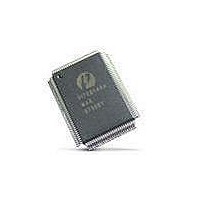PI7C7300DNAE Pericom Semiconductor, PI7C7300DNAE Datasheet - Page 68

PI7C7300DNAE
Manufacturer Part Number
PI7C7300DNAE
Description
IC PCI-PCI BRIDGE 3PORT 272-BGA
Manufacturer
Pericom Semiconductor
Datasheet
1.PI7C7300DNAE.pdf
(107 pages)
Specifications of PI7C7300DNAE
Applications
*
Interface
*
Voltage - Supply
*
Package / Case
272-PBGA
Mounting Type
Surface Mount
Maximum Operating Temperature
+ 85 C
Minimum Operating Temperature
- 40 C
Mounting Style
SMD/SMT
Operating Supply Voltage
3 V to 3.6 V
Supply Current (max)
660 mA
Lead Free Status / RoHS Status
Lead free / RoHS Compliant
Available stocks
Company
Part Number
Manufacturer
Quantity
Price
Company:
Part Number:
PI7C7300DNAE
Manufacturer:
Pericom
Quantity:
135
Company:
Part Number:
PI7C7300DNAE
Manufacturer:
MAX
Quantity:
5 510
PI7C7300D
3-PORT PCI-TO-PCI BRIDGE
the masters in the following fashion (high priority members are given in italics, low
priority members, in boldface type): B, m0, m1, m2, m3, B, m0, m1, m2, m4, B, m0, m1,
m2, m5, B, m0, m1, m2, m6, B, m0, m1, m2, m7 and so on.
Figure 9-1 SECONDARY ARBITER EXAMPLE
Each bus master, including PI7C7300D, can be configured to be in either the low priority
group or the high priority group by setting the corresponding priority bit in the arbiter-
control register. The arbiter-control register is located at offset 40h. Each master has a
corresponding bit. If the bit is set to 1, the master is assigned to the high priority group. If
the bit is set to 0, the master is assigned to the low priority group. If all the masters are
assigned to one group, the algorithm defaults to a straight rotating priority among all the
masters. After reset, all external masters are assigned to the low priority group, and
PI7C7300D is assigned to the high priority group. PI7C7300D receives highest priority
on the target bus every other transaction, and priority rotates evenly among the other
masters.
Priorities are re-evaluated every time S1_FRAME# or S2_FRAME# is asserted at the
start of each new transaction on the secondary PCI bus. From this point until the time
that the next transaction starts, the arbiter asserts the grant signal corresponding to the
highest priority request that is asserted. If a grant for a particular request is asserted, and
a higher priority request subsequently asserts, the arbiter de-asserts the asserted grant
signal and asserts the grant corresponding to the new higher priority request on the next
PCI clock cycle. When priorities are re-evaluated, the highest priority is assigned to the
next highest priority master relative to the master that initiated the previous transaction.
The master that initiated the last transaction now has the lowest priority in its group.
If PI7C7300D detects that an initiator has failed to assert S1_FRAME# or S2_FRAME#
after 16 cycles of both grant assertion and a secondary idle bus condition, the arbiter de-
asserts the grant. That master does not receive any more grants until it deasserts its
request for at least one PCI clock cycle.
To prevent bus contention, if the secondary PCI bus is idle, the arbiter never asserts one
grant signal in the same PCI cycle in which it deasserts another. It de-asserts one grant
and asserts the next grant, no earlier than one PCI clock cycle later. If the secondary PCI
bus is busy, that is, either S1_FRAME# (S2_FRAME#) or S1_IRDY# (S2_IRDY#) is
asserted, the arbiter can de-assert one grant and assert another grant during the same PCI
clock cycle.
Page 68 of 107
Pericom Semiconductor
November 2005 - Revision 1.01












